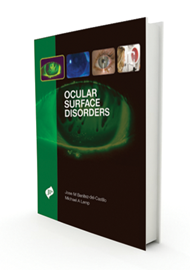This publication provides an excellent overview of ocular surface disease (OSD). Dry eye disease (DED) is the commonest OSD. There has been a recent explosion, both in terms of its diagnosis and the treatments that are available.
A textbook that covers the basic anatomy of the ocular surface, ocular adnexa and tear film, gives a definition and classification of OSD and DED, and provides the latest information about the epidemiology, pathophysiology, management and treatments for these and other ocular surface conditions, is well worth considering. In addition, this book is very well written, with each chapter extensively referenced, covering many aspects of OSD in a single volume.
There are 416 pages, including seven pages detailing the almost 100 eminent international contributors to this book and nine pages of indices. The two pages of appendices provide five diagnostic algorithms including OSD, primary corneal and conjunctival epithelial disease and DED.
There are numerous high quality photographs and fine-detailed, clearly labelled, coloured drawings, tables and flowcharts to support the main textual content. The largest chapters cover Sjögren’s Syndome and other causes of cicatrising conjunctivitis (22 pages), and phototherapeutic keratectomy (18 pages) and the shortest, conjunctivochalasis, lymphangiectasia and conjunctival concretions (four pages) and secretagogues, mucolytics and anticollagenolytics for DED treatments (four pages).
This publication would be particularly useful for the general or trainee ophthalmologist when considering the contributions dry eye disease may make influencing the success of any ophthalmic intervention. This may ensure that their patients regard the outcome more favourably, particularly if ocular comfort and clearer vision is a prime concern.
For the optometrist, specialist nurse practitioner or orthoptist trained for, or considering training in, independent prescribing this would be an excellent investment for their office. One minor criticism might be that there are only two specific contact lens-related dry eye (CLDE) chapters for such a major sub-classification of dry eye disease, however, these provide some ‘pearls’ of information for problem solving the symptomatic patient.
This is a highly readable and useful resource for the busy clinician looking for a concise, but comprehensive overview of many aspects of ocular surface disorders. Although the book is too large and heavy to be regularly carried, it deserves a score of 5/5 in value for money and breadth of up-to-date applicable knowledge.




